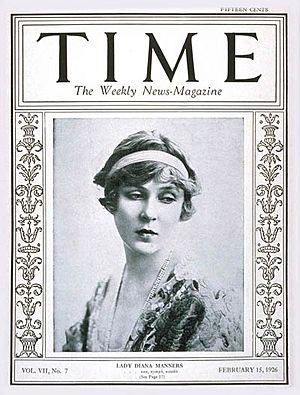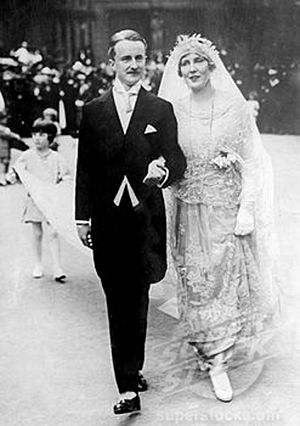Lady Diana Cooper facts for kids
Quick facts for kids
The Viscountess Norwich
|
|
|---|---|
 |
|
| Born |
Diana Olivia Winifred Maud Manners
29 August 1892 London, England
|
| Died | 16 June 1986 (aged 93) London, England
|
| Occupation | Actress, socialite |
| Spouse(s) | |
| Children | John Julius Norwich |
| Parent(s) |
|
Lady Diana Cooper, Viscountess Norwich (born Lady Diana Manners; 29 August 1892 – 16 June 1986) was a famous English socialite and actress. She was well-known in London and Paris for her beauty and charm.
When she was young, Diana was part of a group of smart, artistic friends called the Coterie. Many of them sadly died in World War I. She later married Duff Cooper, one of the few who survived. He became a British ambassador to France. After his death, Diana wrote three books about her life. These books tell us a lot about what life was like for upper-class people in the early 1900s.
Contents
Early Life and Friends
Lady Diana Cooper was born in London, England, on 29 August 1892. Her mother named her after a character in a book. Officially, she was the youngest daughter of the Duke and Duchess of Rutland. However, her biological father was a writer named Harry Cust. Diana found out about this later, but it didn't bother her. She said, "It didn’t seem to matter—I was devoted to my father and I liked Harry Cust too."
When she was young, many people thought she was the most beautiful woman in England. She appeared in many newspapers and magazines. She joined the Coterie, a group of young English aristocrats and intellectuals. This group was very important in the 1910s. Sadly, many of them died in World War I. Some people think they were ahead of their time, like early versions of the "Jazz Age" generation.
Diana was the most famous person in the Coterie. Her friends included Raymond Asquith (whose father was the prime minister), Patrick Shaw-Stewart, and Duff Cooper. Diana was very close to Raymond Asquith and his wife. Raymond's death in World War I made her very sad. She also lost many other friends from her group in the war.
In June 1919, Lady Diana married Duff Cooper. Her parents were not happy about this choice. They wanted her to marry someone with a title and more money, like the Prince of Wales. But Diana chose Duff. In 1929, she had her only child, John Julius Norwich, who grew up to be a famous writer.
Acting and Film Career

During World War I, Lady Diana worked as a nurse at Guy's Hospital in London. She also worked briefly as an editor for a magazine and wrote a newspaper column. Her nursing work made her even more popular. People even sang about her in a popular song!
In 1918, Lady Diana started acting in films. She played herself in a movie called The Great Love. She also appeared in a propaganda film for the war, Hearts of the World. The director, D. W. Griffith, chose her because he thought she was "the most beloved woman in England."
A few years later, she starred in two of the first British color films: The Glorious Adventure (1922) and The Virgin Queen (1923). In The Virgin Queen, she played Queen Elizabeth I. After films, she started acting on stage. She played the Madonna in a play called The Miracle in 1924. This play was a huge success around the world, and she toured with it for twelve years.

Life as an Ambassador's Wife
In 1924, Lady Diana helped her husband, Duff Cooper, get elected to Parliament. She campaigned for him in Oldham. The Coopers were friends with Edward VIII, who later became king.
Lady Diana supported her husband in his political jobs. She even traveled with him to the Far East in 1941, just before the Japanese attacked British Malaya. During the war, she turned her property into a smallholding (a small farm) to grow food for her family. This was important because there were food shortages and rationing. She raised animals, grew crops, and made her own butter and cheese. She also volunteered at a YMCA canteen.
From 1944 to 1948, Duff Cooper was Britain's ambassador to France. Lady Diana became very popular in France as a hostess. The Coopers were known for having an "open house" every evening. Important cultural figures and diplomats could come to their home to socialize, enjoy good food, and have drinks. This was a luxury in Paris after years of wartime shortages.
After Duff Cooper retired in 1947, they continued to live in Chantilly, France, until his death in 1954.
Later Years and Books
Lady Diana became less active in the late 1950s. She wrote three books about her life: The Rainbow Comes and Goes, The Light of Common Day, and Trumpets from the Steep. These three books were later put together into one book called Autobiography (ISBN: 9780881841312).
She passed away at her home in London in 1986 when she was 93 years old. She was buried in her family's tomb at Belvoir Castle.
Books About Lady Diana
Many writers were inspired by Lady Diana.
- Philip Ziegler wrote a book about her called Diana Cooper: A Biography (ISBN: 0-241-10659-1) in 1981.
- Evelyn Waugh created a character named Mrs. Stitch in his Sword of Honour books who was based on Diana.
- Nancy Mitford also used her as inspiration for a character in her novel Don't Tell Alfred.
- In F. Scott Fitzgerald's short story "The Jelly-Bean", a character says she wants to be like Lady Diana Manners.
- Enid Bagnold wrote The Loved and Envied (ISBN: 0-86068-978-6) in 1951. This novel was about Lady Diana and her friends, and how aging affected a beautiful woman.
Her own autobiography was published as a trilogy: The Rainbow Comes and Goes (1958), The Light of Common Day (1959), and Trumpets from the Steep (1960) (ISBN: 0-88184-131-5).
In 2013, her son, John Julius Norwich, put together a book of her letters to him when he was young. It was called Darling Monster: The Letters of Lady Diana Cooper to Her Son John Julius Norwich (ISBN: 978-0701187798).
Images for kids
See also
 In Spanish: Lady Diana Cooper para niños
In Spanish: Lady Diana Cooper para niños



